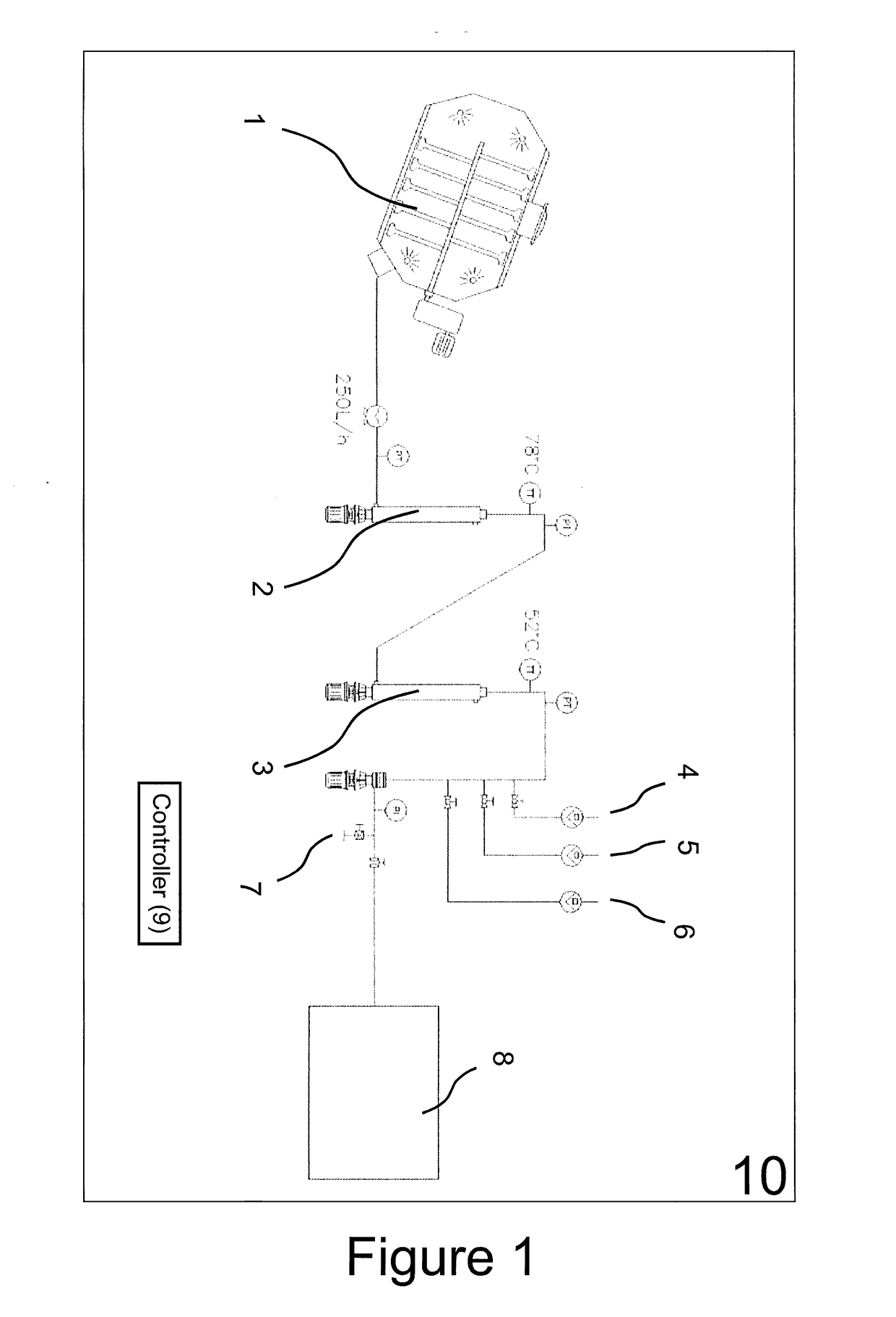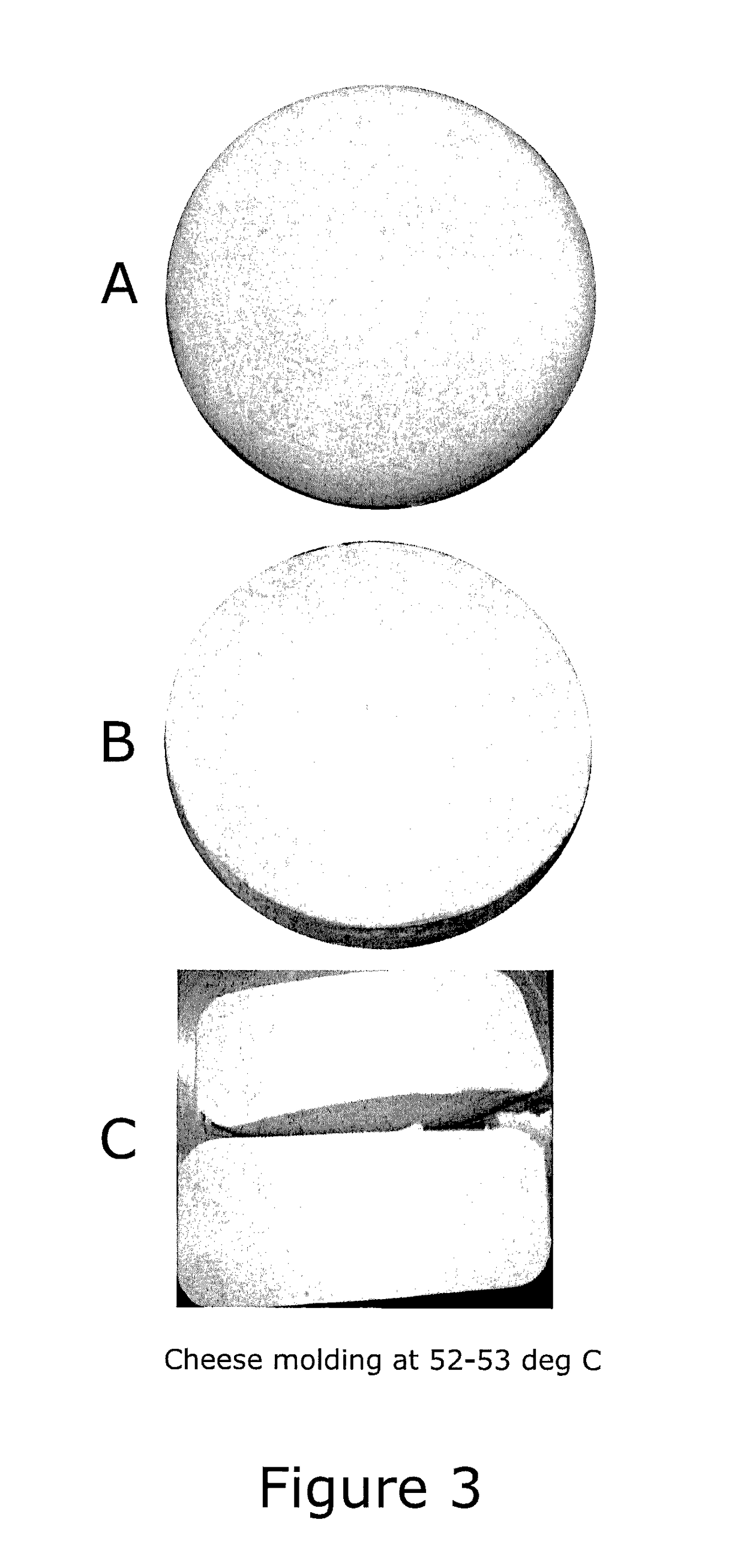Method of making cheese
- Summary
- Abstract
- Description
- Claims
- Application Information
AI Technical Summary
Benefits of technology
Problems solved by technology
Method used
Image
Examples
example 1
[0139]The following recipe has been used for a total batch weight of 200 kg:
Water (kg)89.8SH15 (kg)48.8Butter oil (kg)45.6Skim-milk powder (kg)0Sol. Saltsalt (kg)2.6(brine)water (kg)10.4Sol. Enzymeenzyme (ml)10(rennet)water (kg)0.8Sol CultureA-2010 (g)400(starter)LHB01 (g)200water (kg)2
[0140]The mixing in the Flex-Mix™ Processor (1) went as expected, and a phase conversion was obtained.
[0141]The mix was heated to 78° C. and cooled to 52-53° C. in the scraped surface heat exchangers (2,3). The culture, rennet and brine were added and mixed in by the mixer (7). The final product was homogenous.
[0142]The filling in the Nova machine (8) was working as expected. The filling temperature was about 52° C. and the resulting viscosity was below 12.000 cP as expected. Cheeses were produced. They acidified overnight, and were transferred to cold storage the following morning with a pH1 of 5.2. The structure of the cheeses produced were good, with only very few and small air bubbles.
example 2
[0143]The following recipe has been used for a total batch weight of 262 kg:
Water (kg)124.25SH15 (kg)61Butter oil (kg)57Skim-milk powder (kg)0Sol. Saltsalt (kg)3.25(brine)water (kg)13Sol. Enzymeenzyme (ml)12.5(rennet)water (kg)1Sol CultureA-2010 (g)500(starter)LHB01 (g)250water (kg)2.5
[0144]The mixing in the Flex-Mix™ Processor (1) went as expected, and a phase conversion was obtained.
[0145]The mix was heated to 78° C. and cooled to 52-53° C. in the scraped surface heat exchangers (2,3). The culture, rennet and brine were added and mixed in by the mixer (7). The final product was homogenous.
[0146]The filling in the Nova machine (8) was working as expected. The filling temperature was about 52° C. and the resulting viscosity was below 12.000 cP as expected. Cheeses were produced. They acidified overnight and were transferred to cold storage the following morning with a pH of 5.2. The structure of the cheeses produced were good, with only very few and small air bubbles.
example 3
[0147]FIGS. 2 and 3 show exemplary photos documenting the outcome of filling a respective cheese mould with a pre-cheese mixture as according to example 1 of the present disclosure in a comparative experiment at 36-38° C. (FIG. 2) and a respective cheese mould at 52-53° C. according to the disclosure (FIG. 3).
[0148]As discussed above it has been experienced that at filling temperatures of about 30 to 40° C. the cheese curd will start to coagulate as soon as the rennet is added and any stoppage of the continuous flow to the filling system will create lumps of coagulated cheese curd. When forward flow recommences, these lumps of coagulated cheese will not form a homogeneous cheese with the remaining coagulum with the result that the curd falls apart when subsequently cut, rather like the yolk in a boiled egg. Further problems exist in the fact that the rate of coagulation is fast enough to cause the cheese curd to coagulate to such a viscosity that the top surface of the cheese resemb...
PUM
 Login to View More
Login to View More Abstract
Description
Claims
Application Information
 Login to View More
Login to View More - R&D
- Intellectual Property
- Life Sciences
- Materials
- Tech Scout
- Unparalleled Data Quality
- Higher Quality Content
- 60% Fewer Hallucinations
Browse by: Latest US Patents, China's latest patents, Technical Efficacy Thesaurus, Application Domain, Technology Topic, Popular Technical Reports.
© 2025 PatSnap. All rights reserved.Legal|Privacy policy|Modern Slavery Act Transparency Statement|Sitemap|About US| Contact US: help@patsnap.com



